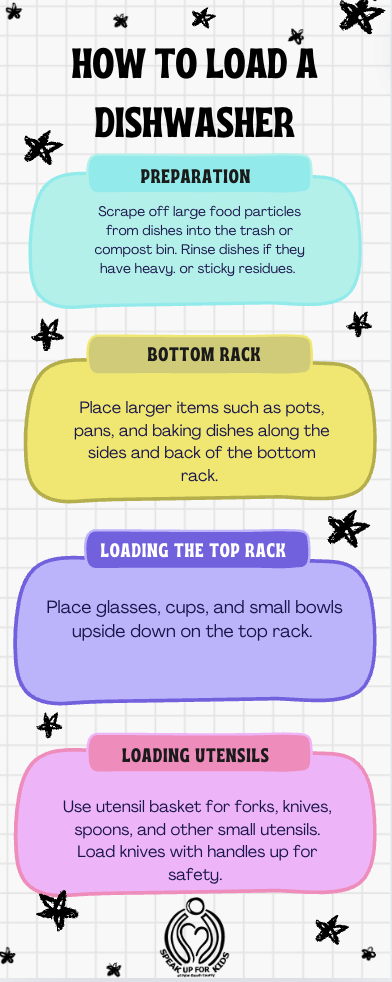How to Load a Dishwasher
Contributed by Speak Up for Kids Student Intern Team — This article was developed through the combined efforts of multiple student interns, each bringing unique skills and perspectives to support life skills education for foster youth.
Overview
Loading the dishwasher might seem like one of those simple household chores you can’t really get wrong—until you open the door after a cycle and find half-clean plates or cloudy glasses. The truth is, how you load your dishwasher can make a big difference in how well your dishes get cleaned and how long your appliance lasts. Whether you’re tired of re-washing “clean” dishes or just want to make your kitchen routine more efficient, this guide walks you through the proper way to load a dishwasher—from prepping and organizing each rack to choosing the right cycle.
Grab your detergent and those dirty dishes—it’s time to make your dishwasher do its best work!
Materials Needed:
Dishwasher detergent
Dirty dishes, utensils, and cookware
Steps:
Preparation:
Scrape off large food particles from dishes into the trash or compost bin.
Rinse dishes lightly if they have heavy or sticky residues. Most modern dishwashers can handle some food residue, but heavy chunks should be removed.
Loading the Bottom Rack:
Place larger items such as pots, pans, and baking dishes along the sides and back of the bottom rack. Make sure they do not block the spray arms.
Load plates and bowls between the tines (the vertical prongs). Plates should face the center, and bowls should be angled downwards.
Ensure items are spaced out to allow water and detergent to reach all surfaces.
Loading the Top Rack:
Place glasses, cups, and small bowls upside down on the top rack. This prevents them from filling with water.
Angle items with deep bottoms so water can drain off.
Load lightweight plastic items on the top rack to avoid warping. Make sure they are secured so they don't flip over during the wash.
Loading Utensils:
Use the utensil basket for forks, knives, spoons, and other small utensils.
Load knives with the handles up for safety.
Mix different types of utensils to prevent them from nesting together, which can impede cleaning.
Place long utensils, like spatulas and serving spoons, on the top rack if there’s space.
Adding Detergent:
Follow the manufacturer’s instructions for the correct amount of dishwasher detergent.
Add the detergent to the designated compartment. If using a detergent pod, place it in the main compartment, not the pre-wash compartment.
Selecting the Wash Cycle:
Choose the appropriate wash cycle based on the load. Use heavier cycles for pots and pans and lighter cycles for glasses and delicate items.
Many dishwashers have an eco-cycle for energy and water savings, which is good for regular loads.
Starting the Dishwasher:
Close the dishwasher door securely.
Press the start button to begin the wash cycle.
After the Wash Cycle:
Allow the dishes to cool before unloading to avoid burns or breaking hot dishes.
Unload the bottom rack first to prevent water from dripping onto clean dishes below.
Check for any remaining water on the tops of cups and glasses and dry with a towel if needed.
Final Thoughts: Tips
Avoid overcrowding the dishwasher to ensure all items get clean.
Regularly clean the dishwasher filter and spray arms to maintain efficiency.
Check your dishwasher’s manual for specific loading recommendations as designs can vary.
By following these steps, you’ll ensure your dishes come out sparkling clean and undamaged!


